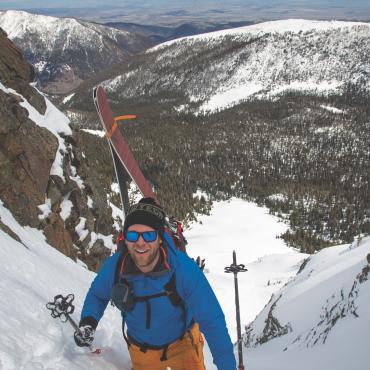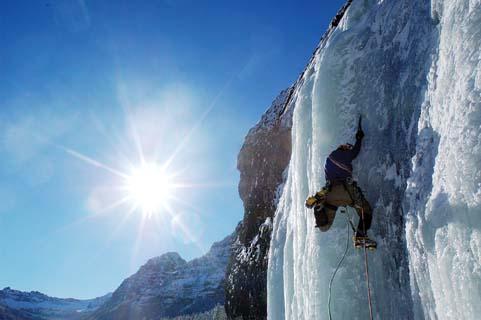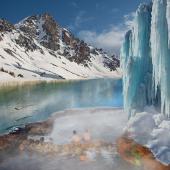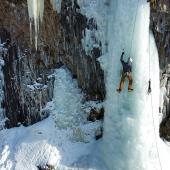Ice Climbing 101
Intro to ice climbing.
“You’ll be fine, just drop your heels, stay calm, and DON'T CUT THE ROPE.” My teacher may not have been a sage, but he certainly knew his Klemheist from a clove hitch. That first day, he taught me to find the fun in a cold, wet, miserable sport: ice climbing.
It’s no coincidence that southwest Montana has produced some of the world's best ice climbers. Hyalite Canyon, Paradise Valley, Cooke City, and the Beartooths all have ice that will test the most experienced ice-ascentionists. But this is also a great place to learn. Here are some things to consider before hanging yourself out on a frozen waterfall.
Before You Go
Ice climbing isn’t something you and your roommate “One Eye” Joe can pick up in a weekend. Find a mentor. Events like the Bozeman Ice Fest are fun, safe ways to try ice climbing. A professional guide is always a safe bet, and you’ll take away a wealth of knowledge that can be applied later.
The necessary gear can cost well over $1,000. This is another reason for hiring a guide or attending an event: you use their gear, and if you don’t enjoy the sport, your investment is minimal. Some people just don’t like standing around in the cold, getting soaking wet, and scaring the bejeezus out of themselves. Weird.
Gear List
After you‘ve determined that ice climbing is indeed for you, here are a few things you’ll need:
Basic climbing skills: tying into the rope, belaying, and avalanche awareness.
Ice tools (consult local shops for the best tools for you).
Crampons (again, local shops can help).
Helmet. A fist-sized chunk of ice can kill.
Harness. It must fit over bulky winter clothing comfortably.
Warm, waterproof clothes. You’ll alternate standing around belaying and climbing, so layers are key.
Multiple pairs of gloves. You WILL get wet, and you’ll need warm hands to safely and comfortably work with the rope and grip your tools.
A dry-coated single or double rope. Stiff, frozen rope is practically unusable, so make sure it’s coated. Double ropes reduce drag and add a degree of security, in case you expertly sink a crampon directly into your cord.
Ice screws. Unless you will always toprope, screws are necessary. Buy a variety of sizes and get the best you can afford—struggling with crappy Russian-made screws while the ice below your feet slowly gives out isn’t ideal. Trust me.
Rock protection. Well-placed rock protection is superior to any screw, so get your money’s worth out of that summer rack.
Proper training and practice. This is key—don’t “wing it.” People die ice climbing. We like you. Ergo, we don’t want you to die. Check the avalanche report, bring the right equipment, and only go with experienced climbers.
Quick Tips
Wear eye protection. Each swing of your tool produces ice chips that could do damage. Plus, you can hit yourself in the face with a tool (it happens).
Drop your heels to engage your secondary crampon points. This provides a more secure platform to stand on.
Don’t repeatedly stab at the ice. Learn to place your tools and feet quickly and solidly, or you’ll soon experience the “Dinner Plate,” when portions of the ice to which you’re clinging fall off. It’s bad.
Don’t cut the rope. It’s pretty easy to do, what with all the medieval weaponry sailing around 60 feet off the deck. Think precision when swinging and kicking.
Don’t freak out. Take deep breaths and enjoy the view between your feet. Yup, you’re secured to a giant frozen Popsicle by a couple of tiny steel picks. Trippy, huh?
Have fun. Ice climbing is a great way to experience a unique environment and meet new people. We’ll see you out there.
Water Ice Ratings
WI 1—Easy walk. The only equipment you'll need is crampons.
WI 2—A steep walk. Tools will help.
WI 3—Some sections of steep ice. You may encounter some vertical ice, but generally only a few feet at a time. You'll need crampons and two hand tools.
WI 4—Continuous sections of steep ice, with rests only on stances in between. You'll need a rope.
WI 5—Vertical ice with very few rest stances. To place protection, you'll usually have to hang off tools or the rope.
WI 6—Overhanging ice, or rotten vertical ice with only sparse protection.












